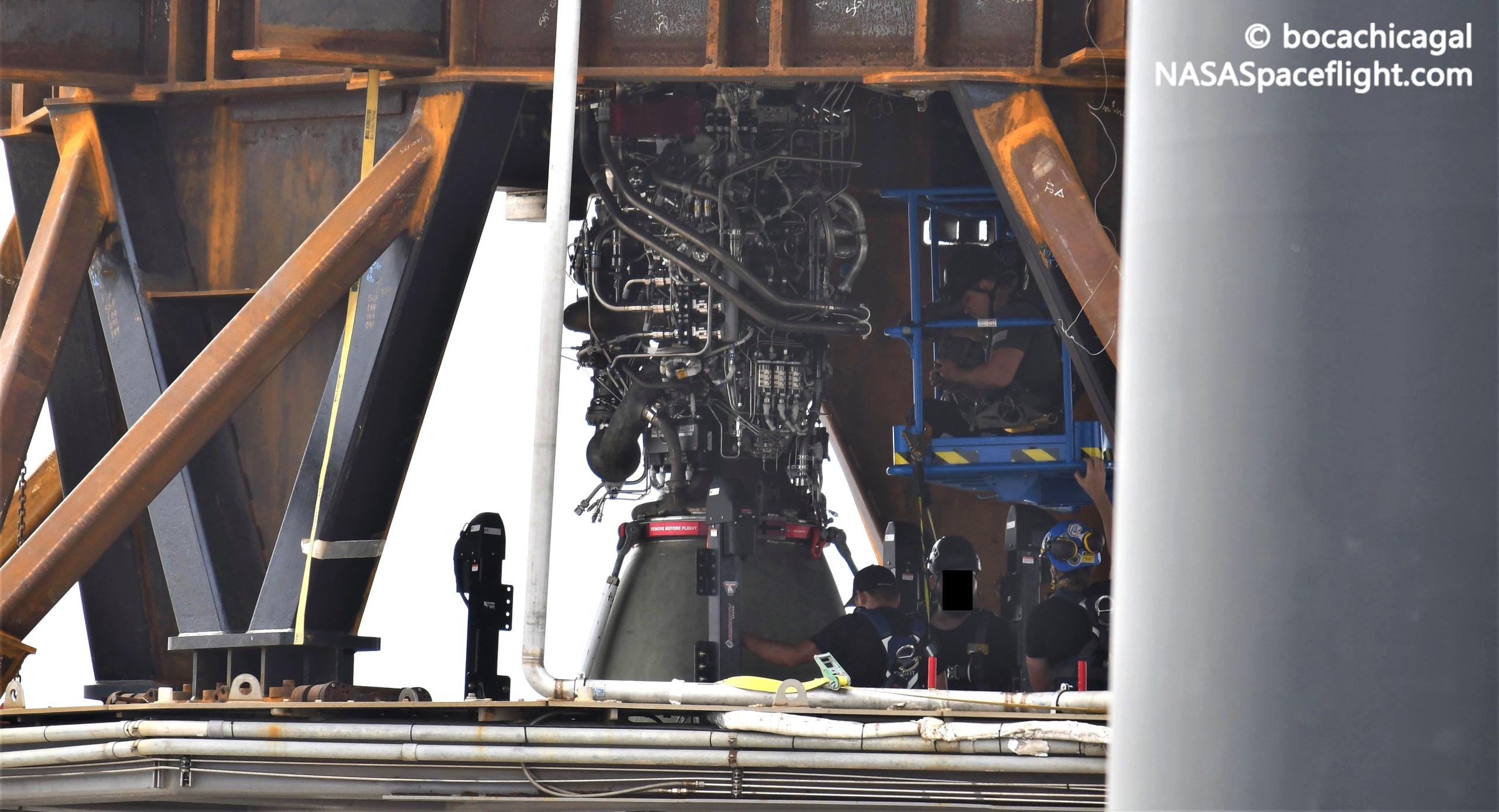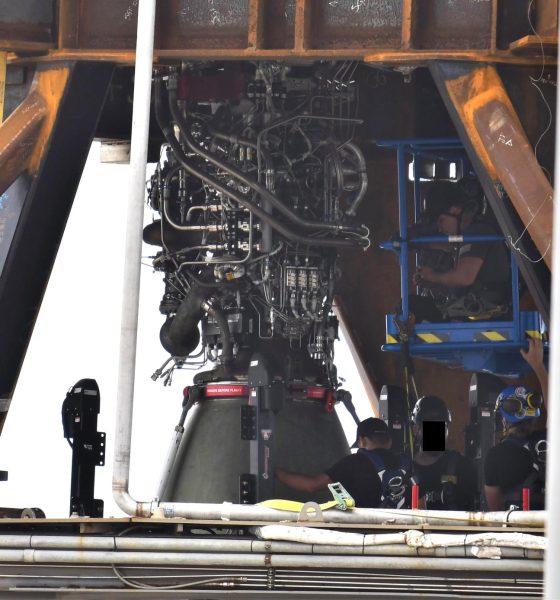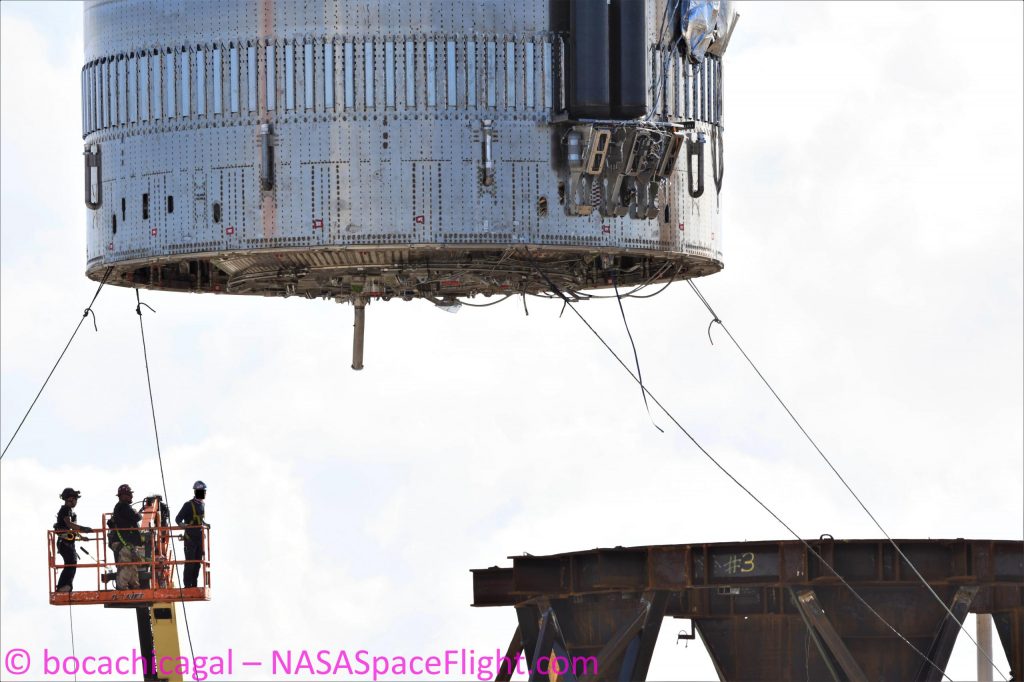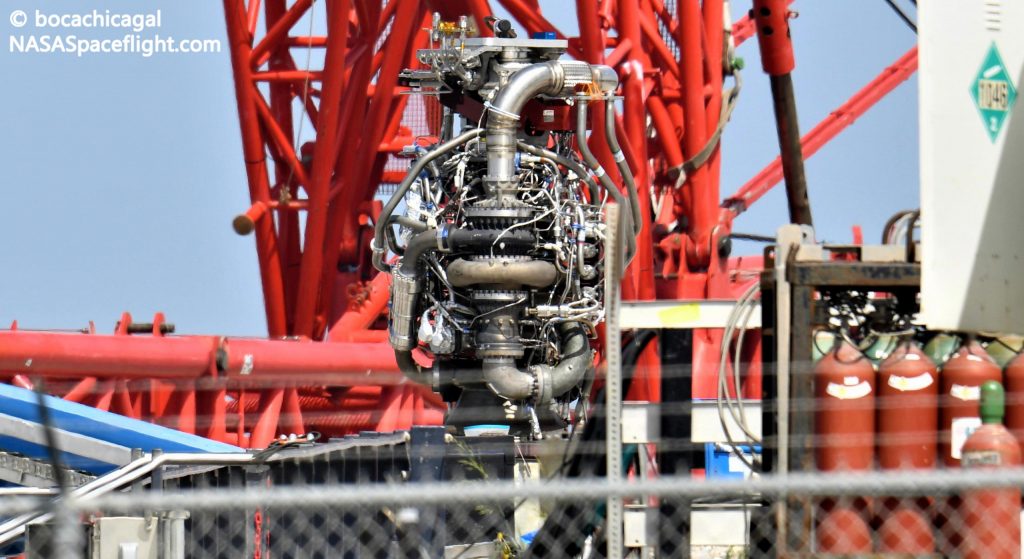

News
SpaceX begins installing Raptor engines on first Super Heavy booster
SpaceX has installed a Raptor engine on a Super Heavy booster prototype for the first time, defying expectations and setting the rocket up for two major tests as early as this week.
On Thursday, July 8th, SpaceX briefly filled Super Heavy Booster 3’s (B3) propellant tanks with benign nitrogen gas. The vehicle seemingly came to life for the first time that morning when it was spotted using its tank vents – a generally incontrovertible sign that the complex mechanical system that is a rocket is functional. Later that day, the public highway and beach adjacent to SpaceX’s launch site were briefly closed for what was expected to be an ambient pressure and/or cryogenic proof test.
Booster 3 never got to the cryogenic proof test – easily confirmed thanks to the frost that forms on most rockets’ exteriors as main tanks are filled with extremely cold liquid nitrogen. No such frost formed, no major venting occurred, and the road was only closed for the first two hours of a six-hour test window.
According to Next Spaceflight’s Michael Baylor, SpaceX did complete a “brief ambient proof” during that relatively short closure, though very little activity was visible during the test. Friday’s 14-hour test window was canceled the next morning, leaving SpaceX the rest of the weekend to prepare the first functional Super Heavy booster for its first truly challenging test – cryo proof.
Instead, late on Saturday, July 10th, SpaceX rolled Raptor 57 (R57) from build site to launch pad and began installing the engine on Booster 3 just a few hours later. Prior to Raptor 57’s installation, most prominent (albeit unofficial) voices in the SpaceX fan community anticipated no more than cryogenic proof testing for Booster 3 – no static fires, in other words.
However, it was fairly apparent that Super Heavy Booster 3 and the modified suborbital launch mount it was installed on were both outfitted for testing more complex than a cryo proof alone. Notably, B3 rolled to the pad with multiple labeled methane pressure vessels (COPVs), extensive plumbing, and autogenous pressurization control panels installed – all of which continued to be actively worked on after the booster was installed at the launch site.

While it’s technically not impossible to build a ground testing Starship prototype that’s capable of a wide variety of tests but never actually used to its full extent, doing so would be well out of character for SpaceX and make little sense in general. As such, it’s not a major surprise that SpaceX has now begun to install Raptor engines on Super Heavy Booster 3. What is surprising is that SpaceX is installing Raptor engines on a first-of-its-kind Super Heavy prototype before any fully integrated booster has completed cryogenic testing.
Based on Starship’s ~18-month test history, there is a real possibility Super Heavy B3 will fail during cryogenic proof testing. Even accepting that SpaceX’s testing processes and expertise have matured dramatically after dozens of Starship tests on the ground and in flight, the chance remains. In other words, SpaceX’s decision to begin installing Raptors on Super Heavy before ensuring structural and mechanical integrity implies some combination of unusual confidence in a prototype as unproven as Booster 3 and a distinct lack of concern at the prospect of losing at least two Raptor engines in a hypothetical test failure.
Knowing SpaceX and CEO Elon Musk’s goals for Raptor, the latter implication isn’t much of a surprise but it’s always interesting to have direct visual evidence that Raptor is, in fact, so cheap to build and easy to install that the minor effort and few days of possible delays required to reduce the risk of losing multiple engines just aren’t worth it.

As such, it’s now clear that Super Heavy Booster 3 will have at least one or two Raptor engines installed during its very first cryogenic proof test – currently no earlier than 12pm to 8pm CDT (UTC-5) on Monday, July 12th. Assuming SpaceX’s confidence is well-placed and Booster 3 passes its first cryogenic tests without issue, the real question now is how many Raptors will be installed and ignited during Super Heavy’s first static fire test?

News
Tesla FSD fleet is nearing 7 billion total miles, including 2.5 billion city miles
As can be seen on Tesla’s official FSD webpage, vehicles equipped with the system have now navigated over 6.99 billion miles.

Tesla’s Full Self-Driving (Supervised) fleet is closing in on almost 7 billion total miles driven, as per data posted by the company on its official FSD webpage.
These figures hint at the massive scale of data fueling Tesla’s rapid FSD improvements, which have been quite notable as of late.
FSD mileage milestones
As can be seen on Tesla’s official FSD webpage, vehicles equipped with the system have now navigated over 6.99 billion miles. Tesla owner and avid FSD tester Whole Mars Catalog also shared a screenshot indicating that from the nearly 7 billion miles traveled by the FSD fleet, more than 2.5 billion miles were driven inside cities.
City miles are particularly valuable for complex urban scenarios like unprotected turns, pedestrian interactions, and traffic lights. This is also the difference-maker for FSD, as only complex solutions, such as Waymo’s self-driving taxis, operate similarly on inner-city streets. And even then, incidents such as the San Francisco blackouts have proven challenging for sensor-rich vehicles like Waymos.
Tesla’s data edge
Tesla has a number of advantages in the autonomous vehicle sector, one of which is the size of its fleet and the number of vehicles training FSD on real-world roads. Tesla’s nearly 7 billion FSD miles then allow the company to roll out updates that make its vehicles behave like they are being driven by experienced drivers, even if they are operating on their own.
So notable are Tesla’s improvements to FSD that NVIDIA Director of Robotics Jim Fan, after experiencing FSD v14, noted that the system is the first AI that passes what he described as a “Physical Turing Test.”
“Despite knowing exactly how robot learning works, I still find it magical watching the steering wheel turn by itself. First it feels surreal, next it becomes routine. Then, like the smartphone, taking it away actively hurts. This is how humanity gets rewired and glued to god-like technologies,” Fan wrote in a post on X.
News
Tesla starts showing how FSD will change lives in Europe
Local officials tested the system on narrow country roads and were impressed by FSD’s smooth, human-like driving, with some calling the service a game-changer for everyday life in areas that are far from urban centers.

Tesla has launched Europe’s first public shuttle service using Full Self-Driving (Supervised) in the rural Eifelkreis Bitburg-Prüm region of Germany, demonstrating how the technology can restore independence and mobility for people who struggle with limited transport options.
Local officials tested the system on narrow country roads and were impressed by FSD’s smooth, human-like driving, with some calling the service a game-changer for everyday life in areas that are far from urban centers.
Officials see real impact on rural residents
Arzfeld Mayor Johannes Kuhl and District Administrator Andreas Kruppert personally tested the Tesla shuttle service. This allowed them to see just how well FSD navigated winding lanes and rural roads confidently. Kruppert said, “Autonomous driving sounds like science fiction to many, but we simply see here that it works totally well in rural regions too.” Kuhl, for his part, also noted that FSD “feels like a very experienced driver.”
The pilot complements the area’s “Citizen Bus” program, which provides on-demand rides for elderly residents who can no longer drive themselves. Tesla Europe shared a video of a demonstration of the service, highlighting how FSD gives people their freedom back, even in places where public transport is not as prevalent.
What the Ministry for Economic Affairs and Transport says
Rhineland-Palatinate’s Minister Daniela Schmitt supported the project, praising the collaboration that made this “first of its kind in Europe” possible. As per the ministry, the rural rollout for the service shows FSD’s potential beyond major cities, and it delivers tangible benefits like grocery runs, doctor visits, and social connections for isolated residents.
“Reliable and flexible mobility is especially vital in rural areas. With the launch of a shuttle service using self-driving vehicles (FSD supervised) by Tesla in the Eifelkreis Bitburg-Prüm, an innovative pilot project is now getting underway that complements local community bus services. It is the first project of its kind in Europe.
“The result is a real gain for rural mobility: greater accessibility, more flexibility and tangible benefits for everyday life. A strong signal for innovation, cooperation and future-oriented mobility beyond urban centers,” the ministry wrote in a LinkedIn post.
News
Tesla China quietly posts Robotaxi-related job listing
Tesla China is currently seeking a Low Voltage Electrical Engineer to work on circuit board design for the company’s autonomous vehicles.

Tesla has posted a new job listing in Shanghai explicitly tied to its Robotaxi program, fueling speculation that the company is preparing to launch its dedicated autonomous ride-hailing service in China.
As noted in the listing, Tesla China is currently seeking a Low Voltage Electrical Engineer to work on circuit board design for the company’s autonomous vehicles.
Robotaxi-specific role
The listing, which was shared on social media platform X by industry watcher @tslaming, suggested that Tesla China is looking to fill the role urgently. The job listing itself specifically mentions that the person hired for the role will be working on the Low Voltage Hardware team, which would design the circuit boards that would serve as the nervous system of the Robotaxi.
Key tasks for the role, as indicated in the job listing, include collaboration with PCB layout, firmware, mechanical, program management, and validation teams, among other responsibilities. The role is based in Shanghai.
China Robotaxi launch
China represents a massive potential market for robotaxis, with its dense urban centers and supportive policies in select cities. Tesla has limited permission to roll out FSD in the country, though despite this, its vehicles have been hailed as among the best in the market when it comes to autonomous features. So far, at least, it appears that China supports Tesla’s FSD and Robotaxi rollout.
This was hinted at in November, when Tesla brought the Cybercab to the 8th China International Import Expo (CIIE) in Shanghai, marking the first time that the autonomous two-seater was brought to the Asia-Pacific region. The vehicle, despite not having a release date in China, received a significant amount of interest among the event’s attendees.








